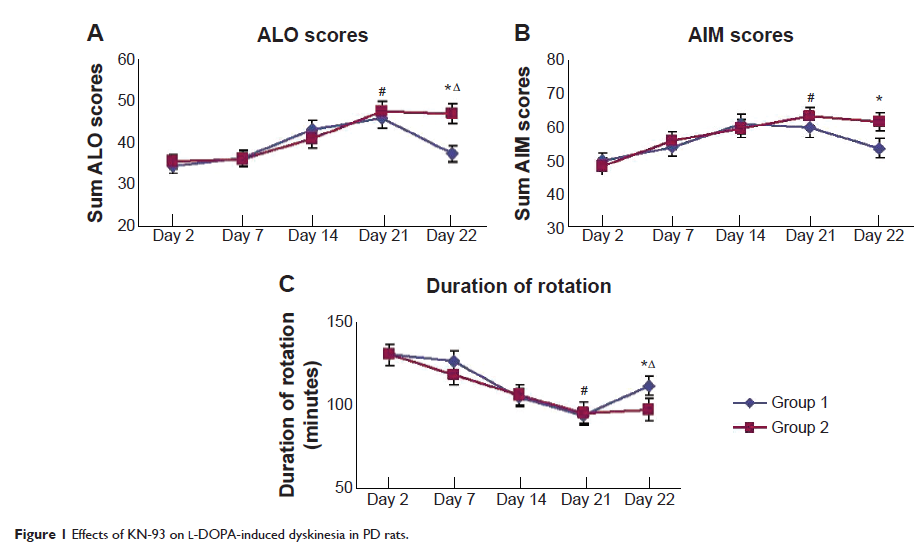108384
论文已发表
注册即可获取德孚的最新动态
IF 收录期刊
- 3.4 Breast Cancer (Dove Med Press)
- 3.2 Clin Epidemiol
- 2.6 Cancer Manag Res
- 2.9 Infect Drug Resist
- 3.7 Clin Interv Aging
- 5.1 Drug Des Dev Ther
- 3.1 Int J Chronic Obstr
- 6.6 Int J Nanomed
- 2.6 Int J Women's Health
- 2.9 Neuropsych Dis Treat
- 2.8 OncoTargets Ther
- 2.0 Patient Prefer Adher
- 2.2 Ther Clin Risk Manag
- 2.5 J Pain Res
- 3.0 Diabet Metab Synd Ob
- 3.2 Psychol Res Behav Ma
- 3.4 Nat Sci Sleep
- 1.8 Pharmgenomics Pers Med
- 2.0 Risk Manag Healthc Policy
- 4.1 J Inflamm Res
- 2.0 Int J Gen Med
- 3.4 J Hepatocell Carcinoma
- 3.0 J Asthma Allergy
- 2.2 Clin Cosmet Investig Dermatol
- 2.4 J Multidiscip Healthc

钙离子 (Ca2+)/钙调素依赖性蛋白激酶 II 在有 L-DOPA (L-3, 4_ 二羟苯丙氨酸) 诱导的运动障碍的大鼠的纹状体的 NMDA 受体 (N-甲基-D-天冬氨酸受体) 亚细胞表达中的作用
Authors Gan J, Qi C, Liu Z
Published Date April 2015 Volume 2015:9 Pages 2119—2128
DOI http://dx.doi.org/10.2147/DDDT.S73868
Received 6 September 2014, Accepted 24 November 2014, Published 13 April 2015
Background: The role of
N-Methyl-D-aspartate (NMDA) receptors is critical to the development of
l-3,4-dihydroxyphenylalanine (L-DOPA)-induced dyskinesia (LID) in Parkinson’s
disease (PD). Ca2+/calmodulin-dependent protein kinase II (CaMKII)
is thought to regulate the expression and activation of NMDA receptors in LID,
but the interaction between LID and CaMKII-modulated NMDA receptor activity is
not clear so far.
Methods: We used
6-hydroxydopamine-lesioned rats to create PD rat model, and at least 21 days of
L-DOPA was administrated followed with or without microinjection of CaMKII
inhibitor KN-93 into the lesioned striatum of all the PD rats and sham rats. A
surface receptor cross-linking assay was used to distinguish expression of
striatal NMDA receptors in surface and intracellular compartments.
Results: L-DOPA treatment
enhanced surface levels of GluN1 expression and reduced its intracellular
expression, but did not change total levels of GluN1 protein in the lesioned
striatum. In contrast, L-DOPA decreased GluN2A surface expression but increased
its intracellular expression. L-DOPA increased GluN2B expression preferentially
in the surface compartment. We also found that L-DOPA increased CaMKII
autophosphorylation at T286 in striatal neurons. The inhibition of CaMKII by
microinjecting CaMKII inhibitor KN-93 into the lesioned striatum largely
reversed the L-DOPA-induced changes in three subunits. In addition, dyskinetic
behaviors of animals were observed alleviated after treatment of KN-93.
Conclusion: Our research
indicates that long-term L-DOPA administration activates CaMKII in striatal
neurons. Activated CaMKII is involved at least in part in mediating
L-DOPA-induced changes of NMDA receptors surface/intracellular expression.
Keywords: glutamate, GluN1,
GluN2A, GluN2B, dopamine, KN-93
